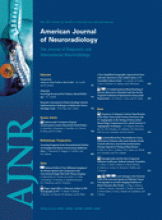Abstract
BACKGROUND AND PURPOSE: DVST is an important cause of ICH because its treatment may require anticoagulation or mechanical thrombectomy. We aimed to determine the frequency of adequate contrast opacification of the major intracranial venous structures in CTAs performed for ICH evaluation, which is an essential factor in excluding DVST as the ICH etiology.
MATERIALS AND METHODS: Two readers retrospectively reviewed CTAs performed in 170 consecutive patients with ICH who presented to our emergency department during a 1-year period to determine by consensus whether qualitatively, contrast opacification in each of the major intracranial venous structures was adequate to exclude DVST. “Adequate contrast opacification” was defined as homogeneous opacification of the venous structure examined. “Inadequate contrast opacification” was defined as either inhomogeneous opacification or nonopacification of the venous structure examined. Delayed scans, if obtained, were reviewed by the same readers blinded to the first-pass CTAs to determine the adequacy of contrast opacification in the venous structures according to the same criteria. In patients who did not have an arterial ICH etiology, the same readers determined if thrombosis of an inadequately opacified intracranial venous structure could have potentially explained the ICH by correlating the presumed venous drainage path of the ICH with the presence of inadequate contrast opacification within the venous structure draining the venous territory of the ICH. CTAs were performed in 16- or 64-section CT scanners with bolus-tracking, scanning from C1 to the vertex. Patients with a final diagnosis of DVST were excluded. We used the Pearson χ2 test to determine the significance of the differences in the frequency of adequate contrast opacification within each of the major intracranial venous structures in scans obtained using either a 16- or 64-section MDCTA technique.
RESULTS: Fifty-eight patients were evaluated with a 16-section MDCTA technique (34.1%) and 112 with a 64-section technique (65.9%). Adequate contrast opacification within all major noncavernous intracranial venous structures was significantly less frequent in first-pass CTAs performed with a 64-section technique (33%) than in those performed with a 16-section technique (60%, P value < .0001). Delayed scans were obtained in 50 patients, all of which demonstrated adequate contrast opacification in the major noncavernous intracranial venous structures. In 142 patients with supratentorial or cerebellar ICH without an underlying arterial etiology, we found that thrombosis of an inadequately opacified major intracranial venous structure could have potentially explained the ICH in 38 patients (26.8%), most examined with a 64-section technique (86.8%).
CONCLUSIONS: Inadequate contrast opacification of the major intracranial venous structures is common in first-pass CTAs performed for ICH evaluation, particularly if performed with a 64-section technique. Acquiring delayed scans appears necessary to confidently exclude DVST when there is strong clinical or radiologic suspicion.
Abbreviations
- AVM
- arteriovenous malformation
- CTA
- CT angiogram
- DVST
- dural venous sinus thrombosis
- ICH
- intracerebral hemorrhage
- INR
- international normalized ratio
- IVH
- intraventricular hemorrhage
- MDCTA
- multidetector CT angiography
- NCCT
- noncontrast CT
- Copyright © American Society of Neuroradiology
Indicates open access to non-subscribers at www.ajnr.org












